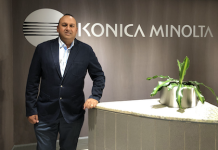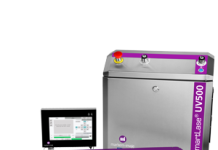Laurel Brunner, writing for the Verdigris Project, says that companies across the globe are starting to appreciate the benefits of automation, not least because it saves them money. Investments into process automation and control have a tangible sustainability dimension because automation can help cut costs and streamline processes.
Ever since process digitisation began with the first steps towards digital typesetting in the 1970s, steady efficiency improvement has been the case in the graphics industry. What is starting to change is that more companies begin to appreciate the contribution automation can make to their sustainability positions.
Kodak recently announced installation of the world’s biggest computer-to-plate (CTP) system. It’s at WKS Group’s web offset printing site in Essen, Germany and counts as the world’s biggest, because the Magnus Q4800 imagesetter is nearly 19 metres long. Four pallet loading systems each with plates of a different format complete the set up.
Size matters here because this fully automated system is based on platesetting technology capable of crunching through an astonishing 50 96-up plates per hour. The Q4800 images plates up to 2.9m wide and the plate loading system can keep it fed with up to 4800 plates online. Over 10,000 square metres of plates can be imaged before reloading is needed. The new CTP system images thermal plates, so it also provides WKS with higher quality and speed, thereby enhancing production capacity.
This is a fully automated system that makes it more energy efficient. It is also efficient because all plates required for WKS’s four Man Roland Lithoman presses (printing 32, 48, 64, 80 pages) are imaged using a single device. The platesetter is running all the time, so the energy load is steady and not spread across multiple plate lines coming up to readiness or winding down. The front end system drives data to the imagesetter as soon as impositions are ready for press. Tight quality control means there are no delays or remakes. This will obviously have a profound impact on energy requirements and the associated emissions over time. Given the state of today’s energy markets and soaring energy costs, that has to be very good news for the Essen site’s bottom line.
WKS prints 350,000 tonnes of paper every year at its Essen site. It offsets the emissions via a local climate protection project. The new CTP system will also help the company to reduce the amount of offsetting associated with current production, because production will be more efficient. Efficiency and eco-friendliness should go hand in hand. That message is getting louder.
This article was produced by the Verdigris Project, an industry initiative intended to raise awareness of print’s positive environmental impact. Verdigris is supported by: FESPA (www.fespa.com), Fujifilm (www.fujifilm.com/sustainability/), HP (www.hp.com), Kodak (www.Kodak.com/go/sustainability), Practical Publishing (www.practicalpublishing.co.za), Miraclon (https://miraclon.com), Unity Publishing (http://unity-publishing.co.uk) and Xeikon (www.xeikon.com).
THE VERDIGRIS PROJECT
http://verdigrisproject.com/





















